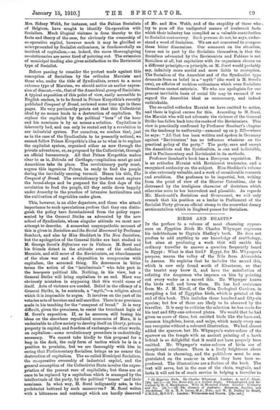BIRDS AND BEASTS.*
IN the preface to a volume of most charming appear- ance on Egyptian Birds Mr. Charles Whymper expresses his indebtedness to Captain Shelley's book. He does not profess to add anything to our knowledge of ornithology, but aims at producing a work that will enable the ordinary traveller to answer a question frequently heard in Egypt : What is that bird P Egypt, for Mr. W hymper's purpose, means the valley of the Nile from Alexandria to Assuan. He explains that he includes the sacred ibis, which is now only found south of Khartoum, so that the tourist may know it, and have the satisfaction of refuting the dragoman who imposes on him by pointing out every wader as a sacred ibis. Mr. Whymper knows the birds well, and loves them. He has had assistance from Mr. J. M. Nicoll, of the Giza Zoological Gardens, in compiling a list of Egyptian birds, which is printed at the end of this book. This includes three hundred and fifty-six species; but few of these are likely to be observed by the traveller. It is easy to criticise the selection he has made for his text and fifty-one coloured plates. We would that he had given us more of these, but omitted birds like the barn-owl, common kingfisher, heron, and snipe, which nearly every one can recognise without a coloured illustration. We had almost added the sparrow, but Mr. Whymper's water-colour of the sparrow on the temple with an ancient painting of a hawk behind is so delightful that it could not have properly been omitted. Mr. Whymper's water-colours of birds are of exceptional excellence. There is a lively brightness about them that is charming, and the publishers must be con- gratulated on the manrer in which they have been re- produced. The illustrations are a feature of the book. The text will serve, but in the case of the chats, wagtails, and larks it will not be of much service in helping a traveller to • (1)Egyptian Birds. By Charles Why-raper. London: A. and C. Black. [20s. net.) (2) The Home-Life of a Golden Eagle. Photographed and De- scribed by H. B. Maciherson. With 32 Mounted Plates. London Witherby anti Co. [50.]—( The Animals of Australia Mammals, Roptile,, and Antehilians. By A.. S. Lucas, M.A., B.Sc., and W. H. Dudley Lo Sone?, C.M.Z.S., M.11.0.11. London: Whitcogabe and Tombs. Ne. net]
• identify the members of these groups. Many tonrista in Egypt this winter should provide themselves with Mr. Whymper's book, and be grateful for the pleasure they will obtain.
We pass on to bird life in the Highlands. Towards the end of April Mr. H. B. Macpherson had news of an eagle sitting hard on two eggs. The eyrie was in a gloomy corrie in the Grampians, but the situation such that he was able, with the help of the stalkers in the forest, to build a shelter of rock and heather from which he could with a notebook and a camera observe the birds without exciting much suspicion. The Home-Life of a Golden Eagle, in which Mr. Macpherson gives the result of his labours, is of great interest, and it is a unique record of the golden eagle's habits. The slender paper-bound volume is prettily got up, and illustrated with a beautiful series of thirty-two photographs. Both eggs hatched, but one eaglet disappeared, and probably died. The other did not leave the nest for eleven weeks, during which Mr. Macpherson, sometimes cold and wet through and sitting in a pool of water, at others devoured by vermin from the filthy nest, spent many whole days at his post. Hares, rabbits, grouse, and once a rat and a lark, were brought by the parents. The growth, games, habits, the lessons in flying of the eaglet, and his final departure from the eyrie, make up a story of bird life never told before.
The Animals of Australia, by Mr. A. H. S. Lucas and Mr. W. H. D. Le Souef, is a more or less popular work which follows scientific lines. The authors are Australian naturalists, Mr. Le Souef being Director of the Melbourne Zoological Gardens. The animals include mammals, reptiles, amphibians, and Ceratodu,s, the lung fish. A volume on birds is being prepared. There is, so far as we know, no work on the Australian fauna on the lines of the present volume, which ought, therefore, to be welcome to those who want a handy compendious volume with trustworthy information. The illustrations consist of numerous photographs. Some are from stuffed museum groups, but many are from specimens living mostly in the Melbourne and Sydney menageries. It is needless to add that the latter are the more satisfactory. The fauna of Australia is a museum of living fossil types, and a short introduction discusses how the ancestors of the existing species came to be where we find them.







































 Previous page
Previous page